 We’re welcoming a return visitor to By Word of Beth today, Emma Walton Hamilton. I got to know Emma in 2010 when I took her Just Write for Kids online/home study course in writing picture books.
We’re welcoming a return visitor to By Word of Beth today, Emma Walton Hamilton. I got to know Emma in 2010 when I took her Just Write for Kids online/home study course in writing picture books.
We’ve since become friends and colleagues, working together in the Children’s Book Hub Facebook Group and on the Hub monthly newsletter, as well as having an ongoing editor/client relationship. Emma’s keen editor’s eye and insightful suggestions have made such a difference in my writing, and in my individual manuscripts. I only wish she edited adult fiction as well!
I can’t say enough good things about Emma’s Just Write Children’s Books courses, and her new product, Editor-in-a-Box. (If you want to see what I have said about them, there’ll be links to my previous posts at the end of this interview.)
Right now, though, we want to hear from Emma herself!
Let’s start with the writing courses, because you have to write before you can edit, right?
BETH: Emma, you launched Just Write for Kids, your 8-week home study course in writing picture books, in 2010, and I know it has been a success. We’ve talked about it in previous interviews (links below). In January of this year, you followed up with Just Write for Middle Grade and Just Write for Young Adults. What led you to create JWFMG and JWFYA?
EMMA: First of all, thank you, Beth! You’ve been such a stalwart supporter of my work, and an incredible colleague and ally in the children’s lit community. I’m so very grateful for all you do.
In the years since I launched the Just Write for Kids picture book course, I received many requests to create middle grade and YA versions, but I simply didn’t have the time to do the necessary research, etc. I was finally able to pull it together thanks to teaching middle grade and YA writing for Stony Brook Southampton’s Creative Writing MFA and in our Children’s Lit Fellows program for the past couple of years. This allowed me to do the research and compile the resources over a period of time, and late last year I gave myself a semester to pull it all together into these two home-study courses.
BETH: Could you give us a glimpse into what’s offered in the two novel-writing courses?
EMMA: Both are 14-week courses, as opposed to the picture book course, which is 8 weeks. Each week, participants receive a new lesson, which builds upon the previous weeks’ lesson(s), and which includes writing assignments, exercises and checklists for works in progress. I should mention that all three courses can be taken from anywhere in the world, at any time, and at one’s own pace, since they are designed as independent studies. Though the material is delivered over 8 – 14 weeks, participants are free to work at their own pace.
The syllabus is similarly structured for both courses, but the content is different. By way of example, below is a partial list of what the chapter book/middle grade course includes (but isn’t limited to). The YA syllabus is structured the same way with respect to the weekly topics, but the lessons within each topic are of course tailored to YA:
WEEK 1: Intro to Middle Grade
What is Middle Grade? (Age ranges, word counts, subjects, gender, genres, etc.); MG vs. Picture Books, Chapter Books, & Young Adult (YA); Getting & Developing Ideas; Writing a Series
WEEK 2: Character
Who’s your hero? Developmental Attributes of 8-12 Year Olds; The 4 Prime Character Questions; Character Journey; Anthropomorphism
WEEK 3: Plot
What’s the Problem? Dramatic Conflict; Classic Novel Structure; The Dramatic Arc; To Outline or Not to Outline? Scaffolding; Story Map; The Hero’s Journey
WEEK 4: Beginnings
First Chapter Musts; The Promise of the Story; Establishing Characters, World, Style, POV & Pacing; Inciting Incident; Back Story; Planting Seeds for the Ending; Info-Dumping; Cliché Openings; The First Line/Opening Sentence.
WEEK 5: Theme
What’s the Big Idea? Relatability; Universality; Revealing Theme; Multiple Themes; Must There be a Theme?
WEEK 6: Voice
Narrative Voice; Point of View; The Unreliable Narrator; Tense; Character Voice – Authenticity & Interiority; Authorial Voice; Passive & Indirect Voice
WEEK 7: Setting & World-building
Describing Your Setting (Sensory Details, Imagery, Time); World-Building (Rules of the World, Culture & Society, etc.); Chapter Books & Illustrated Novels
WEEK 8: Chapters
How Many Chapters Should I Include? Chapter Outlines; The Hero’s Journey; Chapter Ingredients; Transitions; Cliffhangers & Tension
WEEK 9: Scenes
Objectives + Obstacles = Conflict; The Elements of a Good Scene; Pacing; Zooming In & Out; Interiority; Beats; Dramatization vs. Summary; Play-by-Play Narration; Transitions & Turning Points
WEEK 10: Subplots & Secondary Characters
Roles & Archetypes; Stereotypes & Clichés; Edgy Content; Tracking Secondary Characters & Subplots
WEEK 11: Dialogue
Balancing Dialogue & Narration; The Purpose of Dialogue; Character Voice; Subtext; Attribution; Punctuating & Formatting; Info-Dumping; Dialect, Slang etc.
WEEK 12: Narrative Details
Pacing; Backstory; Tension, Suspense & Stakes; Coincidences & Surprises; Non-Linear Narrative; Verse; Edgy “Content”
WEEK 13: Endings
The Job of the Ending; Denouement; Ending Options; Clichés & Other Ending Bewares; Epilogues; Sequels, Series, etc.
WEEK 14 – Editing & Revision
Revision Guidelines; Editing Your Own Work; Submission Formatting & Guidelines; Freelance Editors; Bonuses
BETH: Why two courses? Why not “Just Write Novels for Kids” and leave it at that?
EMMA: There are significant differences between chapter books, middle grade and young adult novels. While some of the craft elements are the same – such as basic storytelling/dramatic structure, character journey, etc. – the focus and degree of detail is quite different with each format, as is the emotional heart.
Chapter books, for instance, tend to not only be much shorter (which gives the author less opportunity for exposition, backstory, world-building, subplots, etc.), but they are also geared to the youngest side of the middle grade reader spectrum, which means the protagonist is younger and the stakes are generally lower than they would be for middle grade or YA. Small stakes – friendships challenged, mastering a new skill – feel large for this age group. This translates to smaller changes for the hero. And chapter books are often part of a series, which means kids must be able to read the books out of order, so characters tend to be more consistent and their emotional journeys from one book to the next less dramatic.
There are equally big differences between middle grade and YA. Middle grade readers are generally between 8-12, YA is 13 and up. As anyone who has ever been a teenager will remember, there’s a vast difference between 10-year-olds and 13-year-olds, let alone 16-year-olds, so the ages of the main characters differ tremendously, and as a result, so do the attendant themes, character journeys and other issues.
Adults can still play major roles in middle grade, for instance, where they tend to take a real back seat in YA. Middle grade novels tend to be more internally focused; they’re more about self-growth and the hero discovering who he/she is in the world, whereas in YA the hero notices the world around them and often moves from a more selfish stage in life to awareness of the feelings and situations of others. YA characters are old enough to be fairly independent and can get into trouble on their own, so there is more grittiness and realism. And of course there are vast differences in terms of what we call “content” – which is edgy language or mature issues. Whereas middle grade is still very tame in this regard, YA can and does include sexuality, profanity, violence, substance abuse, or basically any edgy content relevant to teens today.
Given the range of these differences, I felt it important to create two courses so that I could address the issues relevant to each format in greater detail.
BETH: Since I’ve taken both JWFK and JWFMG, I know that there’s a Facebook Group as well. Could you say a bit about it and its purpose?
EMMA: Absolutely! I created the Facebook Group as a way for the participants in the course to ask me questions and to also learn from one another. All my courses are designed as independent studies, which means participants work at their own pace and do not submit their writing assignments to me for critique (though I do provide suggested answers or examples each week relative to the previous week’s lesson, that students can compare to their own assignments.)
That said, I am always available for questions that come up. All the courses have the ability for participants to post questions within each lesson, which is valuable not only for the person asking the question but also for future participants, since the questions and my answers remain there in perpetuity. But the Facebook Group takes it a step further. It’s a more visible, immediate and social way to ask questions and share comments, and it allows others who have taken the course to respond along with me. This broadens the discussion exponentially, and has the added bonus of giving me feedback and ideas for areas in which I can improve the courses whenever I do updates or revisions.
 BETH: At the end of JWFK, JWFMG or JWFYA, the student has a viable draft manuscript. But that isn’t the end, is it? The draft must be revised and edited. Here’s where Editor-in-a-Box comes in. What led you to create Editor-in-a-Box?
BETH: At the end of JWFK, JWFMG or JWFYA, the student has a viable draft manuscript. But that isn’t the end, is it? The draft must be revised and edited. Here’s where Editor-in-a-Box comes in. What led you to create Editor-in-a-Box?
EMMA: All three courses conclude with a lesson on revision, which incorporates many of the tools, resources and checklists that are in Editor-in-a-Box (with the exception of the bonus materials, such as interviews with editors, a video on the revision techniques and so forth.)
So there’s no upsell, or pressure within the courses to have to buy Editor-in-a-Box after finishing a course.
That said, I created Editor-in-a-Box because in addition to teaching children’s book writing courses and writing children’s books myself, I also work as a freelance children’s book editor – and for years I’ve been seeing clients and students making the same basic mistakes over and over again, causing me to spend my time (and their money!) focusing on avoidable issues more than the heart and meat of the story. I’m also aware that not everyone can afford to work with a freelance editor to polish a manuscript before submission.
So I wanted to come up with a tool that empowered writers to edit their own work into the best possible shape, thereby making the most of working with a freelance editor (should they choose to do so) and/or of every submission opportunity. It was also enlightened self-interest on my part, since I enjoy working with clients on meatier manuscript issues than weeding out grammar gaffes or overused words! Working with clients who’ve used my revision system prior to consulting with me is much more fun.
BETH: Could you open that box to give us just a peek at the contents? (I love the graphic for the product, by the way!)
EMMA: Editor-in-a-Box comes in two versions – one for picture books and one for novels. Both versions contain:
- A comprehensive 6-step revision system, with specific recommendations for revising your story as well as your storytelling – in video, print and checklist form. (I set it up this way because everyone learns differently, so I wanted to offer three ways to absorb and use the information.)
- A list of “Commonly Overused and Unnecessary Words”
- A “Grammar Crammer” – basic grammar and punctuation rules and commonly made errors
- Manuscript formatting and submission guidelines
- A “Guide to Finding, Hiring and Working with Freelance Editors”
- Interviews with several esteemed professional children’s book editors, in audio, transcript and “Top Takeaways” formats
The material is designed to be evergreen – meaning it can be used again and again with every manuscript… it’s lather, rinse, repeat.
Oh, and thank you for your appreciation of the photo of me as the Editor in the Box! My son Sam made that for me. I love it, too!
BETH: Again, there are two products, not just one. Why two?
EMMA: Because the issues are so different when it comes to revising a picture book versus revising a novel. The revision strategies for chapter books and middle grade or YA novels are more or less the same (unlike the writing strategies.) But picture books are poles apart from novels, because of their limitations in length and the necessary economy of words, and also because of the illustrations. For instance, assessing your manuscript to make sure you are not writing what the art will show is a big key to revising a picture book, but is more or less a non-issue with novels. So the revision process is quite different. Also, the interviews in the picture book version of the kit are with picture book editors, and in the novel version, they are with middle grade and YA editors.
BETH: Do you still recommend a second set of eyes on a manuscript? Or are you doing yourself out of freelance editing opportunities by providing this product? (I hope not! I’ve found your manuscript evaluations to be invaluable in making my manuscripts the best they can be.)
EMMA: I will always recommend working with a freelance editor if you can afford to do so, regardless of whether or not you have used my Editor-in-a-Box revision system or any other, for several reasons. First of all, in today’s publishing environment, you get ONE chance to make a first impression. Unless a publishing house editor specifically says they’d be open to seeing a re-write, if they pass on a manuscript, that pass is final; you may not submit a revision. And in some cases, this policy extends to other editors within the same house. So it’s essential to do everything in your power to polish each manuscript into the very best possible shape you can before you submit. It should feel publication-ready (even though an acquiring editor will always find something else to tweak!)
The single best way to achieve that is to have a second set of eyes, and professional ones at that, review the manuscript. All the revision systems and tools – of Editor-in-a-Box or anything else – notwithstanding, we can never truly view our manuscripts with the same degree of perspective that a professional editor can. We’re simply too close to our own work. I mean, I’m an editor as well as an author, and I always hire a freelance editor to look over my manuscripts before I submit them, because when it comes to my own work I lack the perspective of distance that I bring to editing other people’s work.
BETH: What’s next for Emma Walton Hamilton? Any new books in the pipeline? Any other brainwaves like the ones we’ve discussed that are dancing in the back of your mind?
EMMA: My mom and I have several books in the pipeline – a few more installments of our “Very Fairy Princess” series, for starters, with the next books coming out in spring and fall of 2015, respectively. We’re also currently brainstorming another middle grade novel together. And I’m developing two more products for children’s book authors – a School Visit Kit, designed to provide authors with all the tools and resources they need to cultivate and deliver stellar school visits with ease, and a Signings and Readings Kit, to help authors with book signings and readings. Anyone interested in being notified about either of those products should sign up for my mailing list, via the opt-in box on my website at http://emmawaltonhamilton.com
BETH: Is there anything you’d like to add?
EMMA: I’d love to mention two other resources for children’s authors – the Children’s Book Hub, and the Children’s Lit Fellows program – in case any readers might be interested in knowing about them. As you well know, Beth, being a long-time member, the associate editor of the Hub’s newsletter and the co-admin of our Facebook Group, the Hub is a center of resources, information and support for a fabulous community of children’s book authors from all over the world.
In addition to the monthly newsletter highlighting news, events, industry trends and resources of interest to children’s book authors, the Hub provides webcasts of Expert Interviews with authors, editors, agents and other notable members of the children’s book industry, plus monthly Q&A Presentations led by me on craft and business issues with respect to writing and publishing children’s books. There are also invaluable resources, such as lists of agents that represent children’s authors, lists of publishers that accept unsolicited manuscripts, and countless tools and recommendations for better writing, editing, selling and marketing a manuscript, as well as social networking opportunities within the Hub’s Forum and in our Facebook Group. Membership is just $19.95 per month, and anyone interested in joining can do so via http://www.childrensbookhub.com.
The Children’s Lit Fellows program is a yearlong graduate certificate program sponsored by Stony Brook Southampton’s MFA in Creative Writing and Literature. Twelve Fellows per year work independently from home with mentors from our outstanding faculty and, twice a year, they come together at the Southampton campus as a cohort, once in July during the Summer Conference and again in January for a special Publishing and Editing Conference. During their year, Fellows complete one publishable YA or middle grade manuscript, or, for chapter and picture book writers, either a series concept with one completed manuscript or three separate manuscripts. Faculty mentors for the past two years have included Patricia McCormick, Maryrose Wood, Cindy Kane, Amy Krouse Rosenthal, Chris Barton, Libba Bray, Dan Yaccarino, Peter Lerangis, Samantha Berger, Tor Seidler and yours truly. Admission is highly selective, and those interested in learning more should go to http://childrenslitfellows.com.
BETH: Very importantly, how can people find more information on your courses and services as well as Editor-in-a-Box?
EMMA: Thank you for asking! My website will lead people to all the various resources and courses I offer. Here’s the direct link: http://emmawaltonhamilton.com/store/
Thanks again, Beth!
Thank you, Emma! It’s always a joy to host you on my blog.
TWEETABLES: Let others know about this interview! Just click on the Twitter icon to send your tweet.
Blog interview with @ewhamilton by @bethstilborn re #justwriteformiddlegrade & #editorinabox http://wp.me/p4PXqU-1oF
@ewhamilton talking online courses & editing @bethstilborn’s blog #justwriteformiddlegrade #editorinabox http://wp.me/p4PXqU-1oF 
 EMMA WALTON HAMILTON is a best-selling children’s book author, editor and arts educator. With her mother, actress/author Julie Andrews, Emma has co-authored over twenty children’s books, seven of which have been on the NY Times Bestseller list. Emma’s own book, RAISING BOOKWORMS: Getting Kids Reading for Pleasure and Empowerment, premiered as a #1 best-seller on Amazon.com in the literacy category and won a Parent’s Choice Gold Medal.
EMMA WALTON HAMILTON is a best-selling children’s book author, editor and arts educator. With her mother, actress/author Julie Andrews, Emma has co-authored over twenty children’s books, seven of which have been on the NY Times Bestseller list. Emma’s own book, RAISING BOOKWORMS: Getting Kids Reading for Pleasure and Empowerment, premiered as a #1 best-seller on Amazon.com in the literacy category and won a Parent’s Choice Gold Medal.
Emma is a faculty member of Stony Brook Southampton’s MFA in Creative Writing and Literature, where she also serves as Director of the Children’s Literature Fellows program, and Executive Director of the Young Artists and Writers Project (YAWP), an inter-disciplinary writing program for middle and high school students.
Emma also works as a freelance children’s book editor, and hosts the Just Write Children’s Books home-study courses in writing picture books, chapter books and middle grade and young adult novels, as well as the Children’s Book Hub – a center of resources and support for aspiring children’s book authors.
For Emma’s full biography, see this link on her website.
 I have interviewed Emma on several previous occasions (thank you, Emma!) In this interview, she talked about developing the original Just Write for Kids picture book course. In another interview — the first one I did with Emma — we also touched on JWFK. It will give you an excellent overview of Emma and her work.
I have interviewed Emma on several previous occasions (thank you, Emma!) In this interview, she talked about developing the original Just Write for Kids picture book course. In another interview — the first one I did with Emma — we also touched on JWFK. It will give you an excellent overview of Emma and her work.
I recently posted about Just Write For Middle Grade and Editor-in-a-Box. You can find those posts here: JWFMG — Editor-in-a-Box.

Lovely interview, ladies!
My participation in the JWFK Home Study Course was rather serendipitous. I had the link for the course in my “Favorites” folder for quite awhile and would look at it from time to time but the moment was never quite right. This Summer, however, EVERYTHING in my life was in a state of flux. Wondering out loud one day where to go next, I jumped on-line and, honestly, without meaning to, clicked on the link for the course. Well, that sealed it for me. Now was the moment. It was time.
There is so much that I can say about the JWFK Home Study Course. I found it very easy to follow. The instructions are clear and concise, the lessons user-friendly. The course also offers one a chance to really dig deeper into the story. I found myself appreciating so many little aspects that can be so easily over-looked. I highly recommend it.
I am also a proud member of the Children’s Book Hub, the Hub’s Facebook page, and the JWFK Facebook page. There is wonderful knowledge and support to be found in all.
You never know where life will lead you. I’m so grateful it lead me here.
What a fantastic testimonial for JWFK, Kellie-Jeanne! Thank you for sharing that in detail! I’m so glad serendipity led you the way it did this summer, and it’s great to have you in the Hub. I appreciate your contributions there, as well as in the Facebook Group — and here on my blog. Thanks again!
Thanks, Beth! I’m having a blast. Thank YOU for everything you do!
Great! And you’re welcome! 😀
Great interview Beth and Emma. I always want to try something beyond picture book, so I’m always window shopping the courses from Emma. One day.
Thanks, Stacy! I hope you’ll be able to take one of Emma’s classes some day. They’re great!
Great interview!
Thanks, Erik!
Emma is pretty amazing with all the things she does! Those courses sound in-depth and solid. I’ll definitely keep them in mind when I’m next in the market.
You are so right about Emma! I’m glad you plan to keep her courses in mind. Thanks, Teresa!